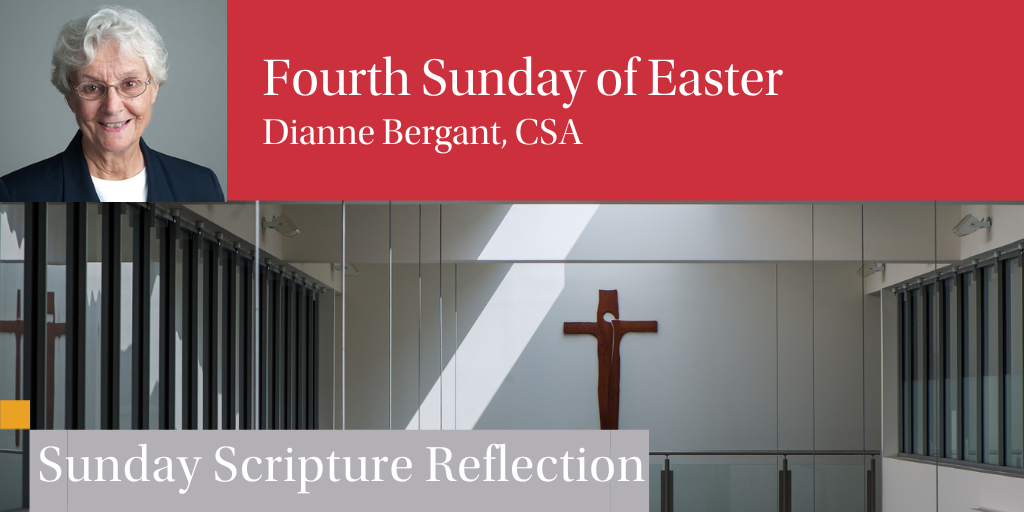
Readings:
Reading I: Acts 2:14a, 36-41
Psalm 23:1-6
Reading II: 1 Pet 2:20b-25
Gospel: John 10:1-10
The Fourth Sunday of Easter has traditionally been known as `Good Shepherd Sunday,’ since readings today elaborate this theme. Their particular focus today is on leadership. Whose leadership will we follow? In the ancient Near Eastern world, kings were often characterized as shepherds of their people, because they were responsible for every aspect of their welfare. This same characterization is used in the Bible to describe the providence of God (Ezekiel 34).
The people to whom Peter speaks in the first reading are cut to the heart when he accuses them of crucifying the one whom God has made both Lord and Christ. They entreat him: “What are we to do?” In responding he exhorts them: “Repent and be baptized.” He assures them that they have been called by God. It is now up to them to decide whether or not to heed that call, accept God as their leader, and allow God to guide them in right paths. In a certain sense, Peter is acting as a shepherd, leading his hearers in a particular direction, guiding them away from false teaching. However, he is actually pointing them in the direction of their real leader, Jesus. That is the one whom they should follow.
In the gospel, Jesus employs the shepherd theme in two ways. He first contrasts the genuine shepherd, who is allowed through the gate of the common sheepfold. The thief is prevented from entering through the gate and must climb over the wall in order to gain entry. Since herding was, and still is, a common occupation in that part of the world, Jesus’ hearers would have been very familiar with the pictures he was drawing. Though several flocks were kept in this common sheepfold, the individual sheep recognized the voice of their own shepherd and followed that shepherd’s lead. They did not follow the voice of a stranger. By means of this metaphoric story, Jesus is saying that those who belong to him will recognize his voice and will follow him.
The psalm response, taken from one of the best known and loved psalms, expands this aspect of the shepherd theme. In touching imagery, it describes the gentle guidance, the fierce protection, and the loving nurturing provided by the true shepherd. This shepherd is not simply a hired hand who does this grueling job merely for wages. Rather, this shepherd is the one who has forged a bond of care and affection for the sheep. The ‘kindness’ referred to in the psalm is the ‘lovingkindness’ associated with covenant commitment. It should be noted, this is the attitude the shepherd has toward the sheep, not the sheep toward the shepherd. God’s love for us is boundless and incomprehensible.
The second part of the gospel contains a slight twist to the theme of shepherd. Earlier it is the shepherd and the thief who go in and out of the sheepfold. Here it is the sheep that do so. Just as the gate is the only legitimate way in and out of the sheepfold, so there is only one legitimate gate. Jesus states that he is that sheep-gate. It is only through him that we can enter the safety of the sheepfold; it is only through him that we can go out confidently in search of nurturing pasturage. He is our way to the peace portrayed in the psalm.
Today’s second reading also assures us that we have been called to follow Christ. Here too the metaphors of sheep and shepherd describe the relationship we have with him, but they are used in a different metaphoric way. Earlier the focus of the shepherding was external behavior; here the focus is on inner disposition. Jesus is identified as the shepherd and guardian of our souls. The author of the letter is speaking to Christians who have strayed from the path of righteous living but have now returned to their shepherd. The image is quite different from the standard image of shepherding, because sheep do not normally return; they must be brought back to the fold by the shepherd. In these readings, the responsibility of the followers of Jesus is emphasized more than Jesus’ care for the sheep.
Following our shepherd may require that we follow him along the path of suffering. We are reminded in the second reading that he suffered for us, leaving us an example that we might follow in his footsteps. It was for our sake that he faced the dangers that often result from living life with integrity. He himself bore our sins in his body upon the cross. He is our model as we too face the dangers of a life of integrity. But follow him we must, for that is the only way to righteousness. It is up to us to decide whether or not we will heed his voice.
Carroll Stuhlmueller, CP, Distinguished Professor Emerita of Old Testament Studies
